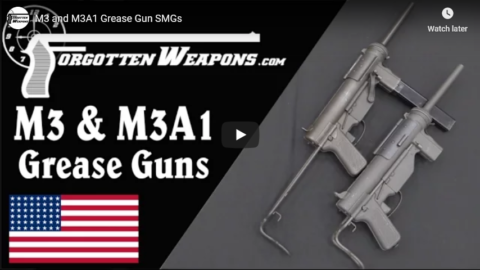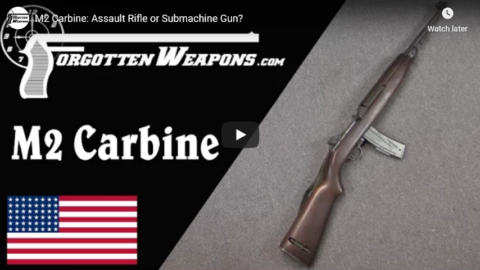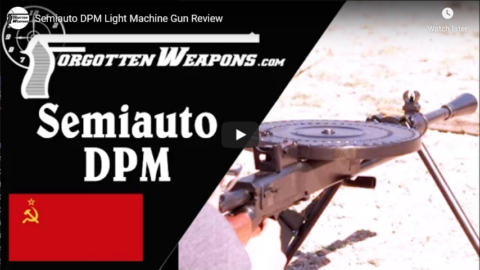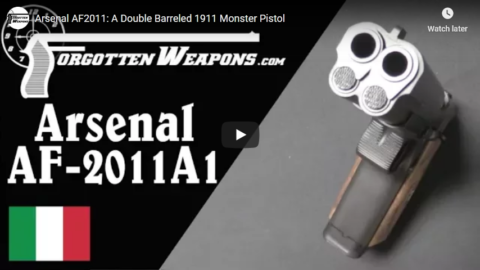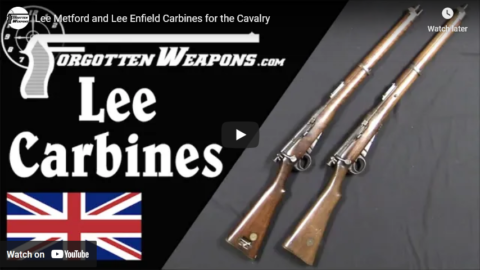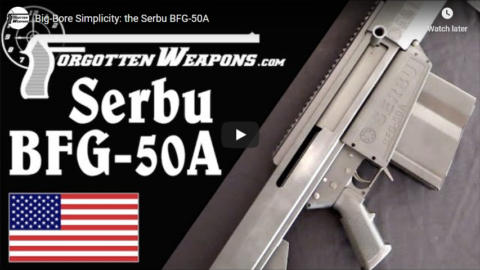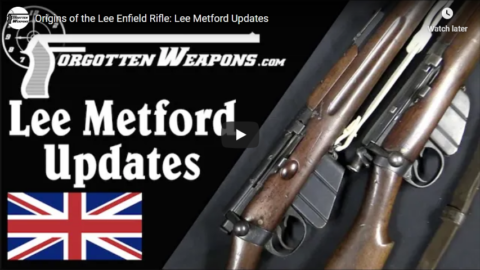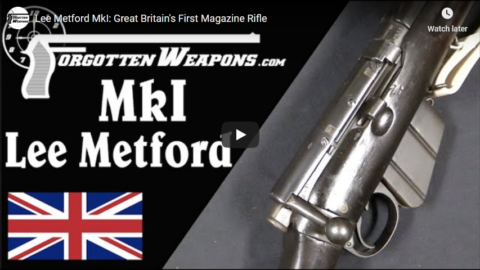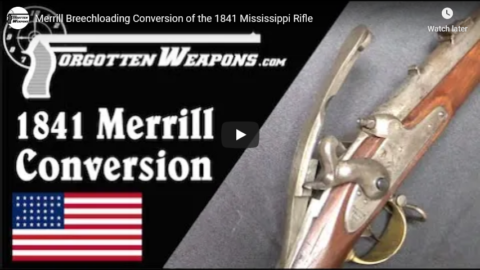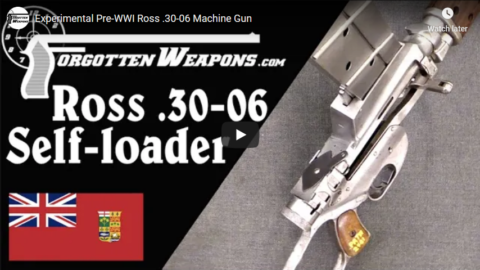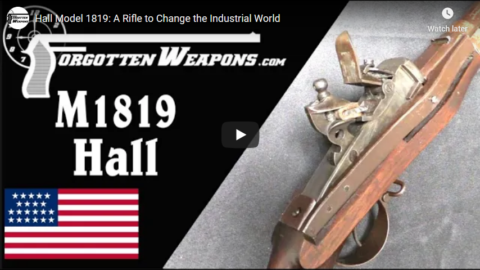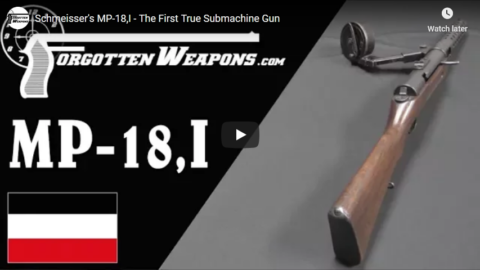Forgotten Weapons
Published 14 Apr 2017The US began looking for a cost-effective replacement for the Thompson submachine gun in 1942, and the “Grease Gun” was the result. Designed by George Hyde (a noted firearms designer at the time) and Frederick Sampson (GM/Inland chief engineer), it was a very simple and almost entirely stamped firearm. Chambered for the .45ACP cartridge, it is notable for its very low rate of fire — 350-400 rpm, which made it quite controllable and easy to shoot for relatively inexperienced troops.
The M3 was a quite reliable gun (and what problems it did have were mostly due to its single-feed magazine and not the gun itself), but a revision program was begun in April 1944. This would produce the M3A1, which further simplified the design by removing the charging handle (which had been the one mechanical trouble point of the M3 anyway) and replacing it simply with a notch in the bolt to cock the gun with a finger.
While the M3 and M3A1 were replaced in front-line service in 1957, they would remain in military inventory as armament for tank crews and truck drivers until 1992 — quite the legacy for such a crude looking weapon!
http://www.patreon.com/ForgottenWeapons
Cool Forgotten Weapons merch! http://shop.bbtv.com/collections/forg…
If you enjoy Forgotten Weapons, check out its sister channel, InRangeTV! http://www.youtube.com/InRangeTVShow
January 19, 2021
M3 and M3A1 Grease Gun SMGs
January 16, 2021
M2 Carbine: Assault Rifle or Submachine Gun?
Forgotten Weapons
Published 23 Mar 2017The M2 Carbine was a mechanically simple modification of the M1 Carbine to allow fully automatic fire. The fire prototypes of the M1 Carbine had actually been selective-fire guns, but that requirement had been dropped by the time the Winchester design was officially adopted as the M1. It was a feature quickly requested by troops once the Carbine entered active service, though.
In 1944 the US Army acknowledged this, and introduced the M2. A total of 217,000 were manufactured at the end of WW2, and did see limited service on Okinawa — and then extensive use in the Korean War and Vietnam War.
The M1 Carbine has long generated controversy among those attempting to rigidly define its role, as it falls awkwardly between the notion of submachine gun and assault rifle, firing a cartridge that is clearly more powerful than a pistol round but equally clearly less powerful than an intermediate rifle round. Its originally intended role was as a personal defense weapon more effective than the 1911 pistol, and in service it always scored high marks for handiness and poor marks for combat effectiveness. The opinion of soldiers using the Carbine in either its M1 or M2 form was very much dependent on what role they expected it to serve.
In my opinion, its light weight and stock design make it a sub-optimal submachine gun, and its light cartridge makes it a sub-optimal assault rifle. But if you need a light and handy carbine to carry a lot and only use in emergencies, it is hard to beat for its time.
http://www.patreon.com/ForgottenWeapons
Cool Forgotten Weapons merch! http://shop.bbtv.com/collections/forg…
If you enjoy Forgotten Weapons, check out its sister channel, InRangeTV! http://www.youtube.com/InRangeTVShow
January 13, 2021
Semiauto DPM Light Machine Gun Review
Forgotten Weapons
Published 7 Mar 2017I have had a parts kit for a Soviet DPM light machine gun (actually a Polish one, but the design is identical) stashed away for many years now, with the hope to eventually have it built into a live gun. When I found out that SMG (makers of the sweet semiauto FG42 replicas) was making a new production run of DP and DPM barrels, receivers, and semiauto trigger conversions I jumped at my chance. I sent my kit to SMG, and they built it into this complete semiauto rifle.
The DP was introduced in 1928 as the standard Soviet light machine gun, and served through World War Two. In 1944, several defects were acknowledged and improved, notably the location of the recoil spring, the grip, and the bipod. This created the DPM, which did see some slight use at the very end of WW2, as well as use by several eastern bloc nations after the war (including in Korea). It would be updated again in 1946 with the RP46 conversion assembly to feed from Maxim belts instead of the distinctive pan magazines (and in fact, SMG is working on a reproduction of the RP46 conversion as well, although it is not yet ready).
Anyway, I took my new semiauto DPM out to the range and got a firsthand understanding of why these guns were so well liked by troops who used them. The design is nothing if not solid, rugged, and dependable. Like other iconic Soviet firearms, the DP/DPM is elegantly simple and bombproof. It is easy and comfortable to shoot, and SMG’s new and very clever linear hammer-fired semiauto conversion gives it a better trigger than any other semiauto machine gun conversion I have handled. Most such guns have really heavy and really creepy triggers, but this is about 8lb and very crisp – and that makes a huge difference in its shootability.
In a nutshell, the gun zeroed easily and shot well, it had no malfuctions in my 3 or 4 pans of ammo expended (using Czech surplus steel-case ammo), and was really a joy to shoot. I would not hesitate to recommend them, and SMG is offered everything from individual parts for you to build yourself to kit build services, and turnkey complete guns.
http://www.patreon.com/ForgottenWeapons
Cool Forgotten Weapons merch! http://shop.bbtv.com/collections/forg…
If you enjoy Forgotten Weapons, check out its sister channel, InRangeTV! http://www.youtube.com/InRangeTVShow
January 10, 2021
Light Machine Guns in Finland: DP-28 vs LS-26
Forgotten Weapons
Published 20 Jul 2017http://www.patreon.com/ForgottenWeapons
Before the Winter War, the standard light machine gun adopted by the Finnish military was the Lahti-Saloranta LS-26. This was a complex and finely built weapon, using a short recoil action and tilting bolt, chambered for the same 7.62x54mm rimmed cartridge as used by Finland’s Mosin-Nagant infantry rifles. The LS-26 fed from 20-round box magazines which are a bit unusual in having a single-feed presentation (which made them difficult to load without a tool, but also prevented potential problems from rimlock).
In total, about 5,000 LS26 machine guns were made for Finland (and an additional 1,200 sold to China in 8mm Mauser). They were apparently quite accurate, but highly prone to malfunctioning in the cold and dirty field conditions of Finnish combat. When the Winter War broke out and Finns began capturing Russian equipment, the Russian DP-28 light machine gun became a very popular alternative to the LS-26.
The Degtyarev DP-28 may not have been as refined of a weapon, but it was much better suited to real combat. It was simple and reliable, and the 47-round magazine capacity was certainly appreciated as well. By the end of the Continuation War, Finland had some 15,000 Degtyarev light machine guns in its inventory, far outnumbering the LS-26s.
Today Karl and I had a chance to fire both weapons side by side (unfortunately, my trigger time on the LS-26 was quite limited, and I was not able to film a full disassembly of it). We both found the LS-26 to be quite a challenging weapon to use effectively, even without any malfunctions. The Degtyarev was a much more usable machine gun.
One other interesting takeaway for us was the remarkable effectiveness of the semiautomatics DP/DPM made by SMG Guns here in the US. It delivered probably 90% of the utility of the original fully automatic version, which is quite impressive. After this comparison, I would recommend it even more heartily than before.
Special thanks to Varusteleka for arranging this shoot!
All photos in this video are courtesy of the excellent Finnish Defense Forces’ Photo Archive:
http://sa-kuva.fiCool Forgotten Weapons merch! http://shop.bbtv.com/collections/forg…
If you enjoy Forgotten Weapons, check out its sister channel, InRangeTV! http://www.youtube.com/InRangeTVShow
January 7, 2021
Arsenal AF2011: A Double Barreled 1911 Monster Pistol
Forgotten Weapons
Published 4 Sep 2017The Arsenal 2011 began as a manufacturing proof of concept, to showcase the technical ability of the company making it (their prior experience was largely in exquisite miniature firearms). It was introduced to the public at SHOT Show a few years ago, and garnered more purchases than had been anticipated.
The gun itself is basically two 1911 frames and slides mated together into a single gun. It has two barrels, two magazines, and two hammers attached to make a single unit. The triggers are also connected together, and pulling either one will cause both barrels to fire simultaneously.
While this sort of firearm is fun to consider (and fantastic for use by movie villains), it is rather difficult to imagine a practical use for it. Most oversized handguns are made for hunting and target competition, but the two-shots-per-trigger-pull nature of the 2011 make it rather unsuited to these uses. It is impossible to shoot a truly small group, as the bullets will always be about an inch apart and they cannot be regulated by the shooter to group together. Not that this stops people from wanting this sort of over-the-top handgun, of course.
http://www.patreon.com/ForgottenWeapons
Cool Forgotten Weapons merch! http://shop.bbtv.com/collections/forg…
If you enjoy Forgotten Weapons, check out its sister channel, InRangeTV! http://www.youtube.com/InRangeTVShow
January 2, 2021
Lee Metford and Lee Enfield Carbines for the Cavalry
Forgotten Weapons
Published 28 Sep 2020http://www.patreon.com/ForgottenWeapons
https://www.floatplane.com/channel/Fo…
Cool Forgotten Weapons merch! http://shop.bbtv.com/collections/forg…
When the Lee magazine rifle was adopted for British military service, it was initially produced as a long rifle for the infantry. To accommodate the cavalry on horseback, a much more compact carbine version was produced. These were initially Lee Metford pattern, but changed to Lee Enfield pattern rifling when the long rifles made the same shift. The carbines were the origin of the cocking-piece-mounted safety, as the Lee Metford rifles in service at the time had no manual safety at all. The cavalry service wanted one, and the safety they came up with was added to later patterns of infantry rifle.
The Lee carbines are designed to be sleek and handy, to easily fit into a cavalry scabbard. The bolt handles are swooped forward slightly and flattened against the receiver. The front sight wings are rounded and the magazine was reduced to 6 rounds, barely extending beyond the receiver. Early examples were fitted with a D-ring on the left side of the receiver socket for use with a single point sling, but this was removed quickly and it is very rare to find carbines with intact sling rings today.
Contact:
Forgotten Weapons
6281 N. Oracle #36270
Tucson, AZ 85740
December 30, 2020
Big-Bore Simplicity: the Serbu BFG-50A
Forgotten Weapons
Published 25 Sep 2020http://www.patreon.com/ForgottenWeapons
https://www.floatplane.com/channel/Fo…
Cool Forgotten Weapons merch! http://shop.bbtv.com/collections/forg…
The Serbu BFG-50A is one of only a couple self-loading .50 caliber rifles manufactured in the US. Work on its design began in 2008, and the first finished examples were produced in 2011. A total of about 500 have been made to date. Mechanically, it is a direct gas impingement action with a 3-lug rotating bolt. Weighing in at 23 pounds, it is significantly lighter than its closest comparison, the Barrett M82A1.
Contact:
Forgotten Weapons
6281 N. Oracle #36270
Tucson, AZ 85740
December 27, 2020
Origins of the Lee Enfield Rifle: Lee Metford Updates
Forgotten Weapons
Published 20 Sep 2020http://www.patreon.com/ForgottenWeapons
https://www.floatplane.com/channel/Fo…
Cool Forgotten Weapons merch! http://shop.bbtv.com/collections/forg…
The Lee Metford MkI had scarcely been introduced when it was modified into the MkI* pattern, This was quickly followed by the MkII and MkII*, the Lee Enfield MkI, and Lee Enfield MkI*. In essence, the changes were:
Lee Metford MkI*: Change of sights to traditional barleycorn and V-notch, and removal of the manual safety
Lee Metford MkII: Update to 10-round, double-feed magazine, move sling rearward, modify cleaning rod to clearing rod
Lee Metford MkII*: Addition of safety lever on cocking piece
Lee Enfield MkI: Change from Metford rifling to Enfield rifling
Lee Enfield MkI*: Clearing rod removedContact:
Forgotten Weapons
6281 N. Oracle #36270
Tucson, AZ 85740
December 23, 2020
Gun Jesus Apocrypha: The Gospel of Browning
Forgotten Weapons
Published 25 Dec 2016A brief Christmas reading, as translated from the original ancient manuscripts by Fr. Frog (http://www.frfrogspad.com/jmb.htm).
http://www.patreon.com/ForgottenWeapons
Cool Forgotten Weapons merch! http://shop.bbtv.com/collections/forg…
If you enjoy Forgotten Weapons, check out its sister channel, InRangeTV! http://www.youtube.com/InRangeTVShow
December 21, 2020
Lee Metford MkI: Great Britain’s First Magazine Rifle
Forgotten Weapons
Published 14 Sep 2020http://www.patreon.com/ForgottenWeapons
https://www.floatplane.com/channel/Fo…
Cool Forgotten Weapons merch! http://shop.bbtv.com/collections/forg…
The British went into the 1880s with plans to adopt the Enfield-Martini as its new rifle, a single shot Martini-action rifle with essentially a sidesaddle of ready-access cartridges on the side of the receiver. It would be chambered for a new .402 caliber black powder cartridge. However, the Small Arms Committee begin looking into the possibility of a magazine rifle instead, and trials of 40+ different systems found three worth considering: a Lee rifle with a box magazine, a Lee rifle with a Bethel Burton magazine, and the Owen Jones rifle. As these trials were concluding, the discovery of smokeless powder threw a wrench in the plans.
After study of the Swiss 7.5×53.5mm cartridge, the British opted to develop a small bore .30 caliber round themselves, which would be the .303 British. This round, originally loaded with compressed black powder before the use of cordite, rendered the plans for the .402 caliber Enfield Martini obsolete. What would have been a justifiable territorial and reserve rifle alongside a .402 magazine rifle was now an orphan. With the new rifle in .303 caliber, a .402 single shot Martini was just an added logistical overhead. Instead, existing Martini rifles would eventually be converted to .303 British.
At any rate, the Lee rifle and magazine were chosen as ideal, and in 1888 a batch was made for field trials across the British Empire. Widely positive reports led to its formal adoption and the beginning of production in 1889 as the Magazine Rifle MkI – later retroactively renamed the Lee Metford MkI and colloquially known as the Long Lee. The example we have today has two very rare original features; an intact manual safety and Lewes pattern sights. Both of these would be quickly removed or replaced in service, and a Mk I* and MkII pattern followed shortly after the adoption of the MkI.
Contact:
Forgotten Weapons
6281 N. Oracle #36270
Tucson, AZ 85740
December 17, 2020
Merrill Breechloading Conversion of the 1841 Mississippi Rifle
Forgotten Weapons
Published 9 Sep 2020http://www.patreon.com/ForgottenWeapons
https://www.floatplane.com/channel/Fo…
Cool Forgotten Weapons merch! http://shop.bbtv.com/collections/forg…
James Merrill of Baltimore had his hand in several Civil War era firearms — rifles built from scratch, conversions of the Jenks carbines, and also conversions of 1841 Mississippi rifles done by the Harpers Ferry Arsenal. Merrill’s conversion involved a knee-joint type lever which could be opened to allow loading of a rifle from the breech. The system was relatively simple, and it was one of three (the others were the Lindner and Montstorm) made in small numbers for testing by Harpers Ferry. It appears that 300 Merrill conversions were done, 100 each of the 1841 Mississippi Rifle, 1842 musket, and 1847 musketoon.
Contact:
Forgotten Weapons
6281 N. Oracle #36270
Tucson, AZ 85740
December 15, 2020
Experimental Pre-WWI Ross .30-06 Machine Gun
Forgotten Weapons
Published 14 Dec 2020http://www.patreon.com/ForgottenWeapons
https://www.floatplane.com/channel/Fo…
Cool Forgotten Weapons merch! http://shop.bbtv.com/collections/forg…
In August 1913, the British War Office wrote to Sir Charles Ross requesting a sample automatic rifle for trials in the UK. Ross was able to submit a prototype in May 1914, which was tested at Enfield — but only fired 308 rounds before the test ended, suggesting that something important probably broke. The gun was a very strange looking contraption, whose Ross MkIII lineage is visible only in the bolt and front of the receiver forging. A long stroke gas pistol was added, and the action flipped upside-down. A large 25-round magazine was fitted, along with a thumbhole style stock that looks very similar to the grip of a Lewis gun. In addition to one example tested at Enfield in .303 caliber, one other model was send to the US for testing, chambered for .30-06. That is the gun we are looking at today, which came to the Canadian War Museum from the collection stored at Fort Knox in the 1970s and 80s.
Thanks to the Canadian War Museum for providing me access to film this extremely unusual Ross for you!
Contact:
Forgotten Weapons
6281 N. Oracle #36270
Tucson, AZ 85740
December 14, 2020
Hall Model 1819: A Rifle to Change the Industrial World
Forgotten Weapons
Published 7 Sep 2020http://www.patreon.com/ForgottenWeapons
https://www.floatplane.com/channel/Fo…
Cool Forgotten Weapons merch! http://shop.bbtv.com/collections/forg…
John Hall designed the first breechloading rifle to be used by the United States military, and the first breechloader issued in substantial numbers by any military worldwide. His carbines would later be the first percussion arms adopted by any military force. Hall developed a breechloading flintlock rifle in 1811, had it tested by the military in 1818, and formally adopted as a specialty arm in 1819.
Hall’s contribution actually goes well beyond having a novel and advanced rifle design. He would be the first person to devise a system of machine tools capable of producing interchangeable parts without hand fitting, and this advance would be the foundation of the American system of manufacturing that would revolutionize industry worldwide. Hall did this work at the Harpers Ferry Arsenal, where he worked from 1819 until his death in 1841.
I plan to expand on the details of a variety of Hall rifle models in future videos, and today is meant to be an introduction to the system. Because it was never a primary arm in time of major war, Hall is much less well recognized than he should be among those interested in small arms history.
Contact:
Forgotten Weapons
6281 N. Oracle #36270
Tucson, AZ 85740
December 11, 2020
Shooting the Webley-Fosbery Automatic Revolver – Including Safety PSA
Forgotten Weapons
Published 10 Aug 2017Following up yesterday’s look at the history and mechanics of the Webley-Fosbery self-cocking revolvers [posted here], today we are out at the range to do some shooting with one.
In terms of handling, it is a comfortable gun to shoot, albeit with some exaggerated recoil because of the very high bore axis relative to the hand. It has an interesting two-part recoil sensation, because the upper assembly takes quite a long time to return forward into battery.
Most importantly, we discovered that this particular Webley-Fosbery has a worn hammer engagement, which results in the firing pin coming into contact with cartridge primers even when it is in the safety notch. In other words, it can — and will — sometimes fire when the action is closed and without any manipulation of the trigger. This is a condition that could happen to any Fosbery revolver, so owners should handle them with this possibility in mind! This is also a great example of why gun safety rules are redundant — occasionally guns do have mechanical failures, so don’t point them at anything you don’t want to shoot!
Thanks to Mike Carrick of Arms Heritage magazine for providing this Webley-Fosbery for this video! See his regular column here: https://armsheritagemagazine.com
Cool Forgotten Weapons merchandise! http://shop.bbtv.com/collections/forg…
http://www.patreon.com/ForgottenWeapons
If you enjoy Forgotten Weapons, check out its sister channel, InRangeTV! http://www.youtube.com/InRangeTVShow
December 8, 2020
Schmeisser’s MP-18,I – The First True Submachine Gun
Forgotten Weapons
Published 14 Aug 2017When Germany began looking in late 1915 for a new weapon ideally suited for the “last 200 meters” of a combat advance, Hugo Schmeisser’s blowback submachine gun would prove to be the weapon that would set the standard for virtually all submachine guns to come. It was a fully automatic-only weapon with a simple blowback action and a rather slow 400 rpm rate of fire. Although relatively heavy, the only real shortcoming of the MP18,I was its use of 32-round Luger snail drum magazines, which was dictated by the German military. These magazines were unreliable and difficult to load, but they were already in production and were a reasonable logistical answer in a time when material and production shortages were an endemic problem in Germany.
The MP18,I managed to see frontline combat only in the closing few months of World War One (50,000 were initially ordered, 17,677 were produced before the Armistice, and only an estimated 3,000 actually saw frontline combat use). During that time, however, it made a significant impression, easily convincing anyone with an open mind that this new type of weapon would play a major role in future wars.
After the end of the war, the Germany Army was prohibited from using submachine guns, so most of the existing ones (including the example in today’s video) were transferred to police organizations instead.
http://www.patreon.com/ForgottenWeapons
Cool Forgotten Weapons merch! http://shop.bbtv.com/collections/forg…
If you enjoy Forgotten Weapons, check out its sister channel, InRangeTV! http://www.youtube.com/InRangeTVShow

